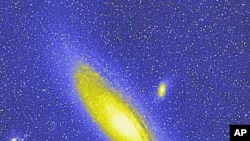Astronomers based in Britain say an enigmatic cosmic object known as an Ultraluminous X-ray Source - or ULX - observed in the neighboring Andromeda galaxy, is the product of a rather ordinary, small black hole.
Scientists who conducted the Durham University-led study say the finding could begin to answer questions about what causes ULXs, which are extremely bright phenomena that usually are too far away for researchers to study closely.
But the ULX spotted in the Andromeda galaxy is only around 2.5 million light years away.
Two competing theories suggest that ULXs are caused either by small stellar black holes that are only a few times the mass of the sun, or medium-sized black holes of around 1,000 solar masses that formed from the merger of much smaller black holes.
The astronomers say their findings indicate the Andromeda ULX came from a regular small-sized stellar black hole that formed when a massive star exploded as a supernova. The black hole’s gravity rapidly captures dust and gas around it, and compresses it into a flat disk, known as an accretion disk, that surrounds the black hole. The disk is spinning at near light speed, which heats up the material, causing it to emit X-rays.
The scientists say their results show that at least some Ultraluminous X-ray Sources are linked to normal, stellar-mass black holes - objects that are commonly found throughout the expanse of the universe.
The Britain-based researchers conducted their research with observations and data collected with NASA’s orbiting Chandra X-ray observatory, the Hubble space telescope, the XMM-Newton X-ray observatory, and the Swift gamma-ray observatory.
The new study is published in the journal, Monthly Notices of the Royal Astronomical Society, as well as in Astronomy and Astrophysics.
Key Discovery: Black Hole Generates Rare Cosmic Object














